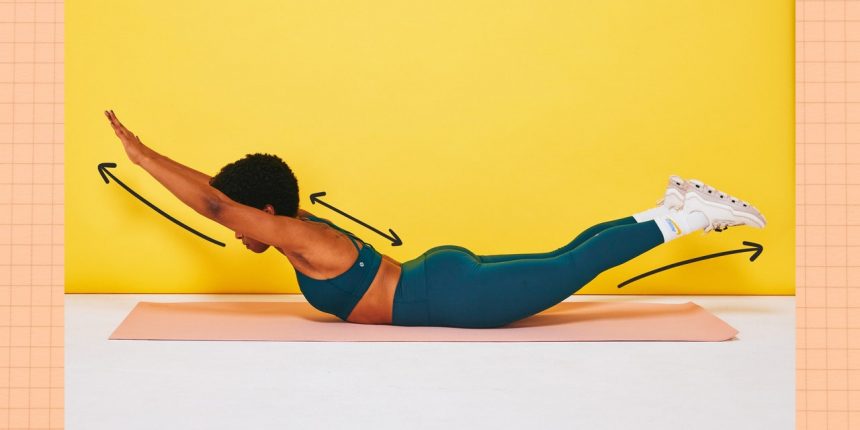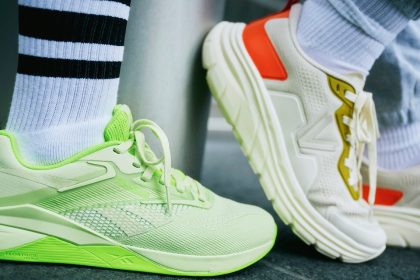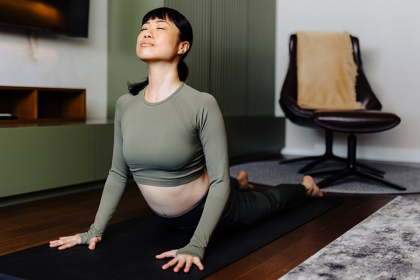Any workout move that has you lying on your stomach may sound way too easy. But the Superman exercise is anything but—providing a muscle-trembling challenge and full-body benefits that are truly no joke.
There are several variations of this no-equipment move (which you may have seen before in yoga classes, Pilates, or bodyweight strength workouts), but the one we’re talking about here involves lying face down with your arms extended in front of you and legs straight out behind you. Then, you lift your limbs off the ground and, voilà, you’re in the pose. (If you picture the namesake comic book character in flight, you’ll understand where the exercise gets its title.)
“It’s a fun one,” Nicole Haas, PT, DPT, founder of Boulder Physiolab in Boulder, tells SELF. Not only does the Superman fire up important backside muscles, but it also technically checks the box for core strength work.
Here, we dig into all that this mighty move has to offer, including which muscles it targets, the full-body benefits, common form mistakes to avoid, how to weave it into your routine, and step-by-step instructions for doing it correctly. So unfurl your yoga mat and get ready to move like Clark Kent.
What muscles does the Superman work?
The Superman is a bodyweight exercise that really fires up your posterior chain—a.k.a. the back of your body, Dr. Haas says. In particular, it hits your erector spinae, a group of muscles that help arch your spine and run down the length of it, all the way from your neck to your lower back, Haas says. It also works your glutes and hamstrings, as well as your posterior deltoids (rear shoulder muscles), she adds.
Depending on how you do the exercise, you can also target the multifidus, a group of low back muscles that help stabilize the spine. To get more specific, if you lift your arms and legs just a couple of inches off the ground and focus on really lengthening through your back—extending from the crown of your head all the way to your feet—you’ll activate your multifidus, Dr. Haas says. You can also fire up this player by lifting up just one arm and the opposite leg at a time (for example, your right arm and left leg, or left arm and right leg, similar to the bird dog exercise). In that scenario, the multifidus kicks on to prevent your spine from rotating, Dr. Haas explains, which is what it naturally wants to do when you’re moving just one upper-body and one lower-body limb at a time.
Keep in mind if you raise your arms and legs higher, you’re not necessarily engaging more muscles or doing an advanced version of the move—it just means you have greater range of motion in back extension, Dr. Haas explains. In fact, for some people, keeping their limbs closer to the ground will deliver more of a challenge.
What are the benefits of the Superman?
The Superman probably isn’t what you envision when you picture core exercises—chances are, moves like crunches, sit-ups, or planks more readily come to mind—but it technically is a core move. That’s because your core isn’t just about your abs (those frontside torso muscles): It also includes the ones in your lower back. And for your core strength to be as well-rounded as possible, it’s important that all these muscles get worked, which is where the Superman can come in clutch, especially if you typically just do crunch-type ab moves. In particular, building lower back strength can help you stabilize better as you perform bigger moves, like squats, allowing you to do them more effectively and safely.
Beyond that, the Superman exercise can help folks who have lower back pain caused by lots of time spent sitting and leaning forward, like those of us who work desk jobs and thus spend the day in a flexion-based pattern, where we’re rounding our spine. Since the Superman moves the body in the opposite direction, into an extension-based pattern where your spine arches back, it can help undo the tension created from parking our butts in a chair all day. Not only does the Superman open up the back in the opposite direction, but it can help alleviate tightness in the front of the hips too.
What kind of exercise is the Superman?
The move certainly makes your muscles quake, but it also puts your back into a bendy position, which begs the question: Is the Superman a strength move or a mobility drill? The verdict: “It’s officially a strength exercise,” Dr. Haas says. In fact, she warns against using it for mobility gains, since it’s really not intended for that—similar to how you shouldn’t grab a pair of dumbbells and do deadlifts if your goal is to lengthen your hamstrings. In the Superman, “you’re not trying to stretch out the front side by going into an arch,” Dr. Haas explains. “You’re trying to strengthen the posterior chain.”
What are common Superman form mistakes?
The goal of the Superman is to fire up your posterior chain, so that’s where you should feel muscles working, Dr. Haas explains. But it shouldn’t be painful, so if you feel pinching in your lower back or neck or crankiness in your shoulders as you do this exercise, it could mean you’re dealing with some muscle tightnesses that warrant making some adjustments so you can do it more comfortably.
For example, having tight hip flexors can shift the load to your lower back as you lift your legs up and cause discomfort there, Dr. Haas says. A possible fix? Reaching outward through your legs and spine instead of focusing on how high you lift them off the ground. Moreover, tightness in your upper back or shoulders can aggravate those areas when you reach your arms overhead. An easy remedy is to bring your arms down by your side.
Another mistake is lifting your legs and arms too high for your current mobility level. Pushing yourself into ranges of motion that are too much for your body can cause pain, so it’s important to respect your limits and only raise your limbs as high as feels comfortable.
Super as it may be, the Superman isn’t for everyone. In particular, people who are pregnant and no longer able to safely lie on their belly should avoid it, as well as folks who’ve recently gotten abdominal surgery, Dr. Haas says. It’s also a must-skip for people who find that pretty much any iteration of the movement causes them pain, she adds. Remember, the Superman exercise should not hurt.
How to slot in Supermans into your routine.
The Superman is an exercise you can do as often as every day, so long as that frequency doesn’t cause pain or make you feel overly sore afterward, Dr. Haas says. Doing it at the end of a work day—if you’re one of those people who sits a lot—can be helpful for alleviating back stiffness that comes from all that sedentary time.
For general strengthening, though, you probably don’t need to do it daily. Slotting it in a minimum of two times a week may be all you need to see gains. There’s no magic number of repetitions and sets—the right amount will depend on your current fitness level and goals—but as a general rule of thumb, you can aim for what the American College of Sports Medicine recommends for any beginner strength training: 1 to 3 sets of 8 to 12 reps. If you don’t want to get that technical, just tune into your body and do an amount that’s challenging but still doable with good form.
You can do it as a dynamic movement—where you’re moving in and out of the pose, as our GIF below shows. Or you can do it as an isometric exercise, where you get into the position and hold for a set time, which would challenge your muscular endurance more. Another option: Do a little of each, suggests Dr. Haas. For example, do 5 to 10 dynamic reps and then hold for 10 seconds.
How to do the Superman exercise:
Katie Thompson
- Lie on your stomach with your legs extended behind you and your arms extended in front of you, palms resting on the floor. This is the starting position.
- Keep your abs and butt tight as you lift your upper body and lower body off the ground at the same time. Keep your neck in line with your spine by resting your gaze on your fingertips as they move.
- Pause for 2 seconds, then lower back down. This is 1 rep.
Demoing the exercise above is Robyn Warren, a health educator and the founder of Geek Girl Strong, a welcoming community that blends fandoms and fitness.
Related:







